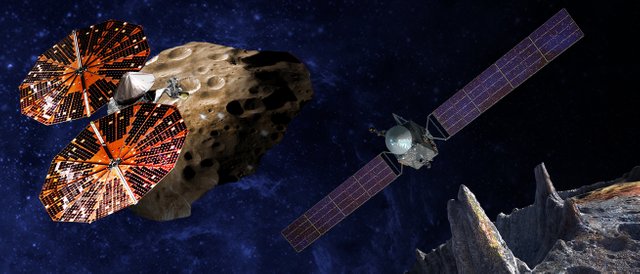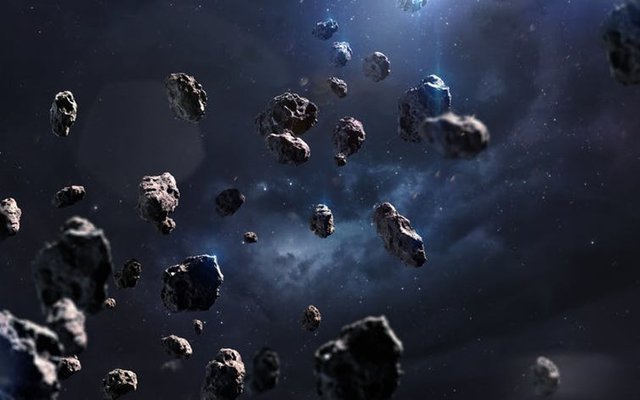2 NEW MISSIONS OF NASA??
Hello Steemians, Today I bring my new post on the 2 NEW MISSIONS OF NASA to be carried on in the year ahead.
If you like the article then it is my humble request to you that kindly do Upvote my post so that it can be motivated in bringing latest articles like this in my coming post too. It is a revolutionary discovery which may take part in deciding future of the world and the entire humankind. Lets see what all 2 NEW MISSIONS OF NASA is all about !!

NASA's Discovery Program has funded some of its most famous missions of the last couple of decades including projects like the Kepler Telescope and the Dawn Spacecraft that has revolutionized our understanding of both our solar system and the universe in.

Finally, NASA has made a decision we're headed to some asteroids. The first mission is called Lucie and it's scheduled to launch in 2021 and do flybys of six different asteroids by 2033. One of those asteroids is in the main asteroid belt between Mars and Jupiter but most of Lucy's targets are trapped in patches along Jupiter's orbit where Jupiter's gravity sort of balances out the Sun. Astronomers think some of these asteroids formed near Jupiter and Saturn and others started further out but got caught by Jupiter's gravity. When they got too close so investigating a whole bunch of them gives us a way of studying what was going on throughout the early solar system. Some of Lucy's main tools are improved versions of cameras from New Horizons that studied Pluto which we'll use to photograph and map the surfaces of all of those asteroids.

The second new mission set to launch in 2023 is called Psyche. After the asteroid is scheduled to start orbiting in 2030. After its full name is 16 psyche and it's one of the biggest asteroids in the entire asteroid belt but that's not the only reason NASA is so interested in it. Every asteroid we've ever visited was made of rocks and minerals and ice but 16 psyches the only big asteroid we've ever seen this made of metals like iron and nickel. The stuff that's deep down in Earth's core and astronomers aren't quite sure why all that metal ended up in one place it's possible that 16 psyche is the core of an ancient would-be planet that either never finished forming or somehow got ripped apart billions of years ago who of the Psyches orbiters goals are to map the asteroids magnetic and gravitational fields which will help us learn where and how it formed we'll also find out whether it's really metal all the way down or if there's more to 16 psyche than meets the eye closer to home.

A study published in the journal Nature Geoscience has resurrected an idea explaining the formation of our Moon. Most astronomers subscribe to the giant impact hypothesis where a mars-sized proto planet called Via crashed into the earth billions of years ago and the moon formed out of debris from that College but there have always been some lingering issues with the giant impact hypothesis for one thing whatever happened to Thea. Thea's remains should make up about 70 percent of the moon but moon rocks brought back by the Apollo astronauts were very similar to earth rocks so similar that they seemed like they couldn't have come from anywhere but it's possible that Earth and Theia just happened to be made out of identical rocks.
Researchers recently found that there's about a 30% chance that the early Earth could have been hit by something so chemically similar to it but another possibility is that Earth was never hit by a giant impactor like Thea at all. So for this new study a group of planetary scientists simulated what the moon would look like if material came from a bunch of medium sized things hitting Earth instead of one big one the idea has been around since the 80s but they've given it new life by simulating almost a thousand early solar systems and they showed that it would only take about 20 impacts to form the moon as we know it today considering everything that was flying around the early solar system 20 good whacks definitely isn't out of the question and with so many different objects contributing to the moon it would make sense that none of these rocks would stand out from the rest so the moon should look a lot more like the earth than anything else because the earth makes up more of it than anything else which is exactly what we've seen don't expect astronomers to rush out and change their textbooks though the giant impact hypothesis still does a pretty good job of explaining the moon formation it's just not the only possibility so it'll still take a lot more research to find out exactly how we got our Moon.
REFERENCES:
I hope you enjoyed learning about 2 NEW MISSIONS OF NASA. If you love dreaming and learning science then please follow me, @adi-mac
If you are interested in various domains of Science and Mathematics then join the @steemstem project, team to support high quality STEM (Science,Technology, Engineering and Mathematics) related contents. Join them in steemit.chat to interact with the science authors from all over the world.
Thank you for reading my content !!
Don't Forget to Read My Previous Articles:
- LATEST SPACE MISSIONS OF 2018 : ISRO
- Metallic M-Class Asteroid Worth 10,000 Quadrillion Dollars : NASA MISSION
- Alien Solar System With A Number Of Planets?? : NASA
- Last Door of Richest Padmanabhaswamy Temple : No One Can Open??

This is high quality work and very informative. Welcome to SteemSTEM!
Thanks a lot!!
Super presentations!!
Thanks for your generosity!!